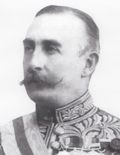Educated at Eton College (1859-1863) and Trinity College, Cambridge (1864-1867); served in the Scots Fusilier Guards (1867-1869); pursued racing career (1869-1876); was a newspaper correspondent in Paris, Spain, Turkey and Afghanistan; participated in the Second Afghan War (1879) and Egyptian campaign (1882); served as a military secretary to Governor General of Canada Marquess of Lansdowne (1883-1885); served as an aide-de-camp to General Middleton during the North West Rebellion of 1885; returned to England (1886), where he succeeded to his father's titles (1891); appointed Governor General of Canada (25 Jul 1898); Minto's term as Governor General of Canada was marked by controversy and political strife. He was inexperienced in government, distrustful of politicians and determined to play an active part in Canadian public life. His criticism of his government's handling of the South African War crisis, his interest in reforming the Canadian Militia and his support for the British colonial secretary Joseph Chamberlain's imperial preference campaign all caused tension. More positively, he attempted to forge closer ties between French and English Canadians, to preserve the written and material record of Canada's past, to promote sports (the Minto Cup in lacrosse) and to protect Canada's northern miners and native peoples from the neglect and mismanagement of government; was succeeded by his brother-in-law Earl Grey, whose sister he married in 1883; assumed the office of Viceroy and Governor-General of India (18 Nov 1905 - 23 Nov 1910). |

